Reserve Bank of Australia Annual Report – 2021 Banknotes
The Reserve Bank is responsible for producing and issuing Australia's banknotes. In this role, the Bank ensures that banknotes in circulation are of high quality and that the threat of counterfeiting is low. In late 2020, the Bank concluded the decade-long Next Generation Banknote (NGB) program with the release of the new $100 banknote. This program involved the design and development of a new banknote series to make Australia's banknotes more secure from counterfeiting. The new banknote series has been well received by the public and counterfeiting rates have remained low.
The COVID-19 pandemic continued to affect banknote demand throughout 2020/21. The demand for $50 and $100 banknotes remained strong in the second half of 2020, but abated over the first half of 2021. The demand for lower-value banknotes remained subdued, consistent with the ongoing decline in the use of cash as a means of payment. The continued decline in cash use for transactions has implications for the economics of banknote distribution and, as a result, the Bank will be commencing a consultation on banknote distribution arrangements in the second half of 2021.
Circulation
The strong growth in banknote demand experienced at the onset of the COVID-19 pandemic continued into the first half of 2020/21, with growth in banknotes in circulation peaking at 17.8 per cent over the 12 months to January 2021 before declining later in the year. Commercial banks purchased $9.7 billion in banknotes from the Reserve Bank during 2020/21, with more than half of these purchases occurring in July and August 2020. The value of banknotes in circulation subsequently declined by 3.1 per cent over the six months to June 2021 as commercial banks returned more (typically unfit) banknotes to the Reserve Bank than they purchased. This decline was more protracted than the usual seasonal pattern, with the value of banknotes in circulation having grown at a below-trend rate. Overall, the value of circulating banknotes increased by 6 per cent over 2020/21, which is close to the average of the past decade. At the end of June 2021, there were 1.9 billion banknotes in circulation, worth $95.5 billion. As a per cent of nominal GDP, the value of currency in circulation reached a historical high of 4.8 per cent during the year.
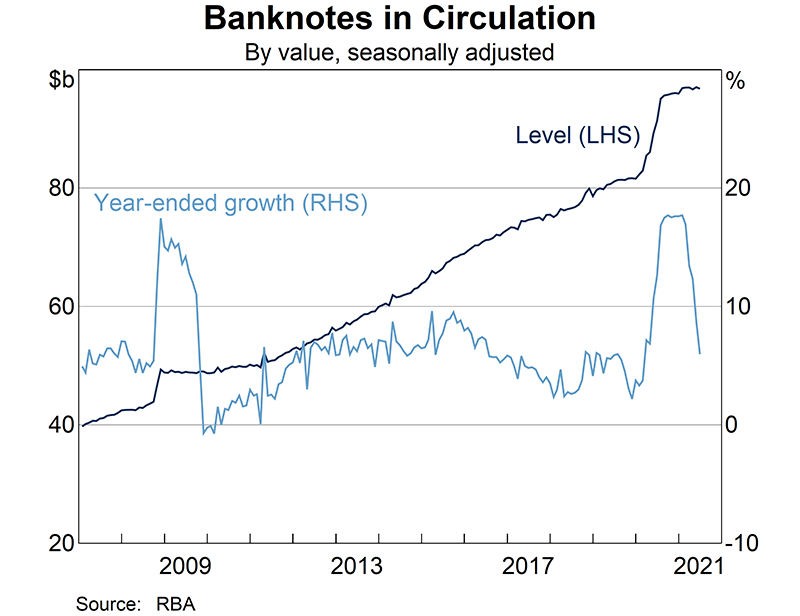
The growth in banknotes in circulation over 2020/21 was driven by demand for $50 and $100 banknotes. The strong demand for high-denomination banknotes suggests an increased desire in the community to hold banknotes as a precaution or store of wealth during the pandemic.[1] Subdued issuance of low-value banknotes since July 2020 can be explained by the decline in the use of cash as a means of payment. These shifts are an acceleration of trends in banknote demand that have been occurring for many years, which look set to continue. In a survey conducted by the Reserve Bank in October 2020, 44 per cent of individuals reported they had used cash less since the start of the pandemic; of those, 63 per cent felt this change in their payment behaviour would continue in the future.
| $5 | $10 | $20 | $50 | $100 | Total | |
|---|---|---|---|---|---|---|
| FY2020/21 | −1.0 | −0.6 | −1.4 | 5.9 | 7.2 | 6.0 |
| 10-year average(a) | 4.9 | 3.9 | 3.2 | 5.6 | 6.7 | 5.9 |
|
(a) 10 years up to and including February 2020 Sources: RBA |
||||||
The Bank also surveyed retail businesses about their acceptance of cash. In September 2020, 96 per cent of merchants accepted cash, a small decline since the previous survey in February 2020. While cash acceptance remains high, the Bank will continue to monitor this through its involvement on the Australian Payments Council.
The Bank also monitors how accessible cash is for the community as measured by distance to an ATM or bank branch. Access has been broadly unchanged since 2017 and generally remains good, with around 95 per cent of people living within about 5 kilometres of a cash access point.[2] However, there is limited access to cash in some regional and remote parts of Australia. People in these areas must travel longer distances to access cash, and the available access points do not always have nearby alternatives.
Despite the strong growth in banknotes in circulation, the continued decline in cash use for transactions is putting pressure on the economics of the cash system. Banks have rationalised their ATM and bank branch networks and have sold some of their ATMs to third parties. With these pressures having been exacerbated by the impact of the COVID-19 pandemic, the Reserve Bank will be consulting with industry on banknote distribution arrangements in the second half of 2021.
Next Generation Banknote program
To ensure that Australian banknotes remain secure against counterfeiting, the Reserve Bank has issued an upgraded series of banknotes in recent years.[3] The new $5 banknote was released in 2016, the new $10 in 2017, the new $50 in 2018, and the new $20 in 2019. The new $100 banknote, the final denomination to be upgraded as part of the Reserve Bank's decade-long Next Generation Banknote (NGB) program, entered general circulation in October 2020.
The new $100 banknote continues to feature portraits of Dame Nellie Melba and Sir John Monash. Melba was an internationally renowned soprano who performed in Australia, Europe and the United States and taught at the Melba Memorial Conservatorium of Music, now the Melba Opera Trust. Monash was an engineer, soldier and civic leader recognised for his influence in the building-construction industry and service as a commander in the First World War. On the new $100 banknote, a number of dynamic security elements are integrated with the top-to-bottom window, including a reversing ‘100’ in the Shrine of Remembrance, which Monash was instrumental in building. There is also a three-dimensional fan with colourful lines, representing Melba's career as a performer.
The NGB program was a complex, long-running and ultimately successful program. It delivered an upgraded polymer banknote series that retains many of the key design elements of the first polymer banknote series – including the colour, size and people portrayed – but also has a range of innovative new security features. As a result, the upgraded banknote series is significantly more secure from counterfeiting than the first polymer banknote series. It also has a new feature to assist people with vision impairment – a series of raised bumps – which has improved the accessibility of Australia's banknotes.
Research conducted for the Reserve Bank indicates that the NGB series has been well received by the Australian public. The 2020 Reserve Bank Online Banknote Survey found that a majority of people have now used a new banknote and around three-quarters indicated they liked them. Features that respondents particularly liked included their durability, their ‘Australian look’ and the fact that the banknotes are waterproof. Respondents also liked the inclusion of clear windows and the tactile feature on the banknotes. In contrast, some participants expressed concern about the slipperiness of the banknotes and that they are made of plastic.
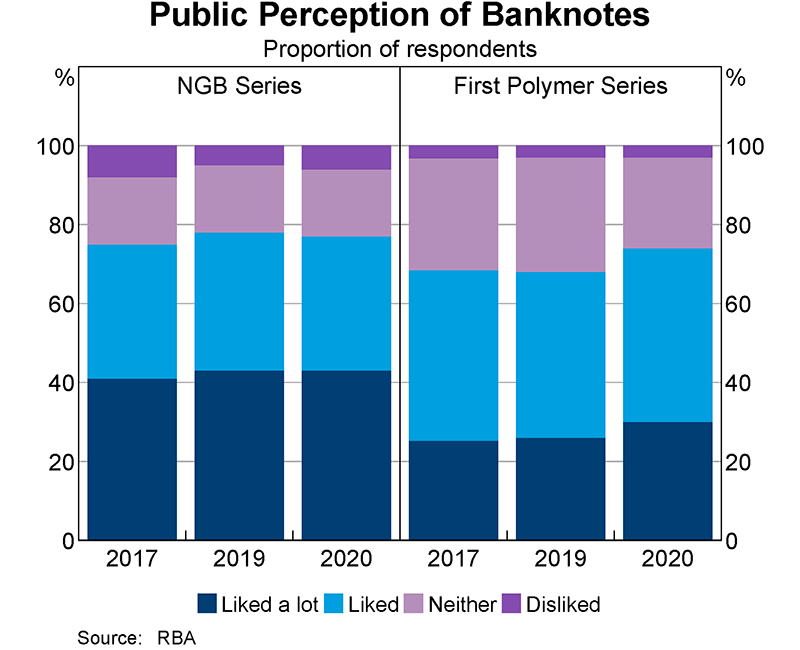
As at the end of June 2021, new series banknotes made up two-thirds of all outstanding $5 and $10 notes, over a third of $50 notes and a quarter of $20 notes (the ‘saturation’ rate). However, in samples of notes in day-to-day use (active circulation), the proportion of new series $5 and $10 notes were much higher at more than 95 per cent. This high rate, coupled with little change over the last year, suggests that saturation of the smallest denomination banknotes has reached a limit. As such, there will be some older series banknotes that are unlikely to be returned to the Reserve Bank in the near term, if at all, as they are stored, lost or held abroad. The new $100 note, which was released in October 2020, made up just 2.8 per cent of all $100 notes in circulation and is not expected to increase quickly, given the high volume of the denomination that entered circulation during the early part of the pandemic together with it mainly being used as a store of value rather than circulating more actively.
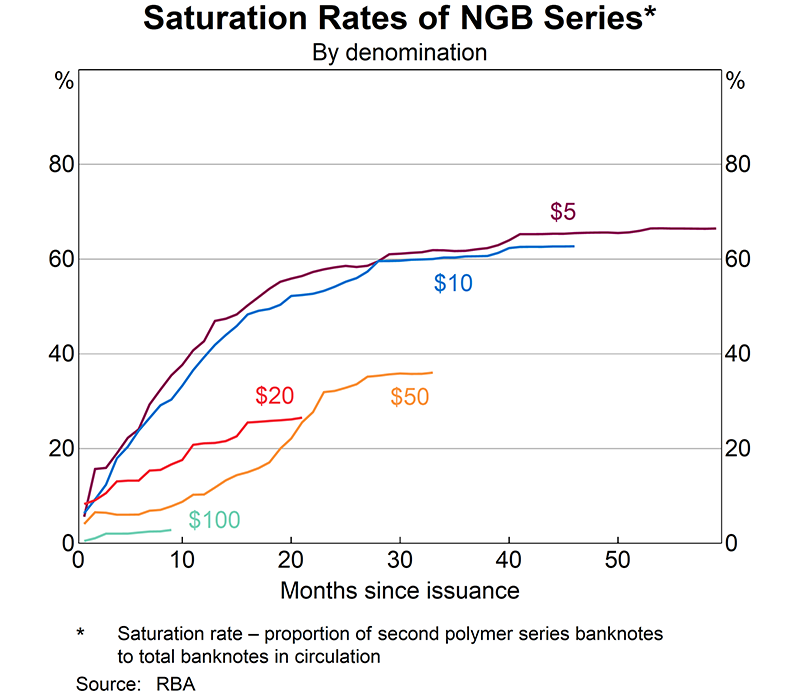
Distribution and storage
The Reserve Bank operates as a wholesaler of banknotes, issuing banknotes to commercial banks, which, in turn, have arrangements in place to distribute banknotes around the country to meet the demands of their customers. As the Bank had drawn down the stock of previously issued banknotes during the COVID-19 pandemic, almost all of the issuance by the Reserve Bank in 2020/21 were new banknotes; less than 1 per cent of the $9.7 billion issued to commercial banks in 2020/21 were banknotes that had previously been in circulation but had since returned to the Bank and were deemed fit for reissue. As noted above, the bulk of this distribution activity occurred in the first half of the 2020/21 financial year.
The Reserve Bank's purpose-built National Banknote Site (NBS) at Craigieburn, Victoria is the primary centre for the Bank's processing, distribution and storage of banknotes. The distribution site in Sydney was closed for business-as-usual distribution activities in late 2019, although it retains a holding of banknotes for contingency purposes. The contingency arrangements at the Sydney site were activated for three weeks in late July and early August 2020 (as well as in March 2020) in response to heightened demand for banknotes in the face of domestic transport restrictions associated with the pandemic. Once concerns about transport eased, the Sydney site returned to being a contingency-only site for the remainder of 2020/21.
The Reserve Bank aims to maintain a high quality of banknotes in circulation as high-quality banknotes are more readily handled by machines and make it more difficult for counterfeits to be passed. Accordingly, the Bank has arrangements that encourage the commercial banks and the cash-in-transit companies to sort the banknotes they handle to agreed quality standards. Based on this sorting, banknotes that remain fit for circulation are redistributed, while those that are deemed unfit are returned to the Reserve Bank. These unfit banknotes are assessed to confirm their authenticity and quality and are then destroyed. In 2020/21, the Bank received $3.9 billion worth of banknotes deemed unfit for recirculation.
The Reserve Bank also removes banknotes from circulation through its Damaged Banknotes Facility. The facility is offered to members of the public who unwittingly have come into possession of damaged banknotes or whose banknotes are accidentally damaged. Claims that meet the requirements set out in the Bank's Damaged Banknotes Policy are paid based on their assessed value.
Throughout 2020/21, the Damaged Banknotes Facility continued to operate to ensure that reimbursement of claims to members of the public could occur. Physical distancing and reduced staffing associated with the COVID-19 lockdown in Victoria (where damaged banknotes are assessed) meant that processing of claims was slower than usual. However, with easing of restrictions in late 2020, much of the backlog of claims has now been cleared. In 2020/21, the Bank processed around 11,600 claims and made $5 million in payments. Of these, 20 claims worth around $234,000 were received from members of the public whose banknotes were damaged during the Australian 2019/20 bushfires. To date, the Bank has paid a total of $426,000 for 54 claims relating to these bushfires.
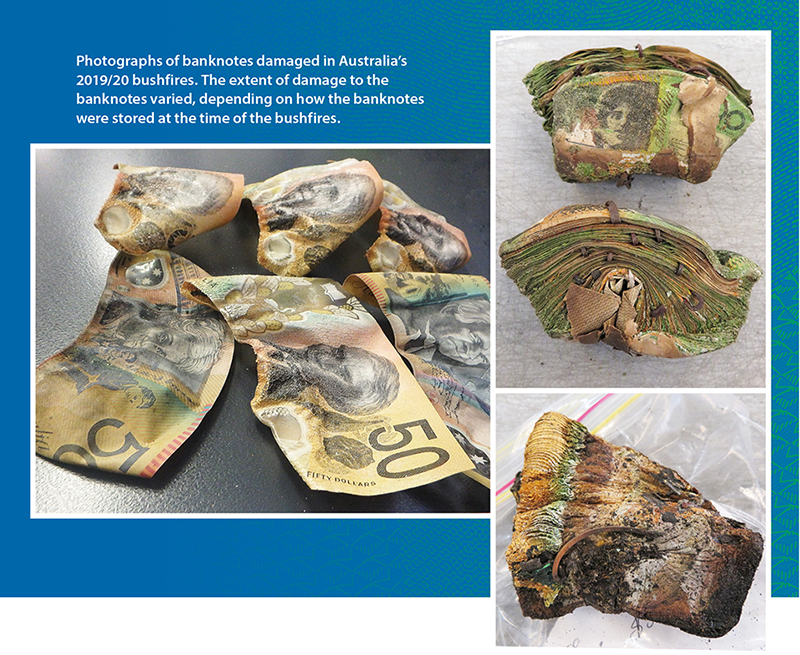
Counterfeiting rates
The level of counterfeiting in Australia remains low by international standards. In 2020/21, around 18,000 counterfeits, with a nominal value of $1.4 million, were detected in circulation. This corresponds to a counterfeiting rate of around 10 counterfeits detected per million genuine banknotes in circulation. Although the total number of counterfeits and the counterfeiting rate have decreased, counterfeiting of the $100 denomination remained elevated in 2020/21 compared to previous years. Counterfeiters continue to target first polymer series banknotes; there has been very little counterfeiting of the new NGB banknotes to date.
| $5 | $10 | $20 | $50 | $100 | Total | |
|---|---|---|---|---|---|---|
| Number | 3 | 25 | 242 | 7,261 | 10,572 | 18,103 |
| Nominal value ($) | 15 | 250 | 4,840 | 363,050 | 1,057,200 | 1,425,355 |
| Counterfeiting rate (counterfeits per million banknotes in circulation) | 0.01 | 0.2 | 1.3 | 7.7 | 24.7 | 9.5 |
|
(a) Figures are preliminary and subject to upward revision because of lags in counterfeit submissions to the RBA Source: RBA |
||||||
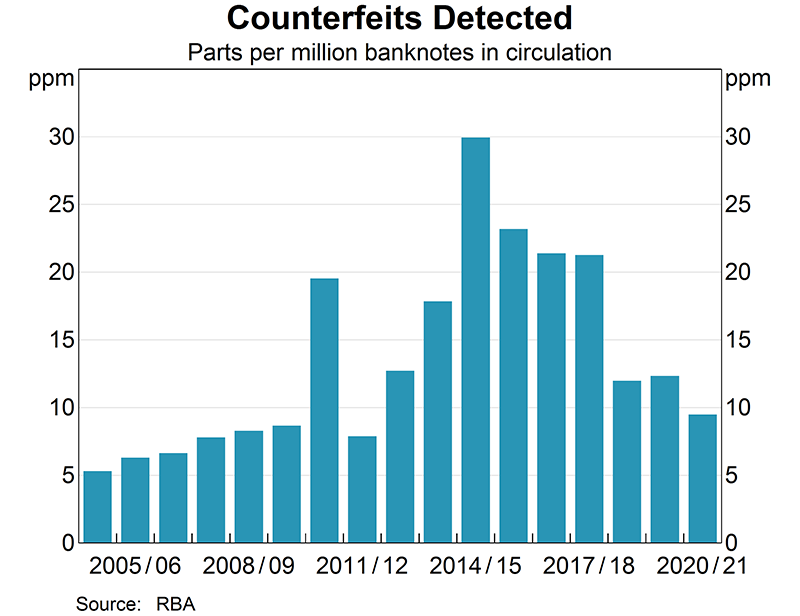
Law-enforcement efforts to investigate and prosecute counterfeiting operations play a significant role in managing the threat of counterfeiting.[4] The Reserve Bank supports court proceedings around Australia through the provision of information about counterfeit currency and expert witness statements. In 2020/21, the Bank completed 187 statements relating to 2,728 counterfeits. In addition, the Bank is aware of 21 court proceedings that occurred during the year relating to the possession, passing and making of counterfeit currency.
At times, police operations are able to prevent counterfeit banknotes from entering into general circulation. In 2020/21, police seizures of counterfeits accounted for 18 per cent of all counterfeits detected, double the long-run average and driven primarily by an increase in higher volume seizures during the year. In 2020/21, a case that began in 2019 and was led by the Australian Federal Police also concluded and can now be reported. The case involved the seizure of more than 382,000 counterfeit banknotes, with a face value of $30 million, and represents the largest seizure of Australian counterfeit currency to date. The banknotes were being imported into Australia for use in Chinese New Year festivities; however, their resemblance to genuine banknotes means they are deemed counterfeit under the Crimes (Currency) Act 1981. The banknotes are of very poor quality, but have previously been accepted as genuine banknotes, and so preventing such a large quantity of counterfeit banknotes entering Australia is of particular significance.
Banknote research and development
The Reserve Bank maintains an active banknote research and development program to develop cost-effective counterfeit-resistant security features and detection technologies for Australian banknotes. The primary purpose of this program is to ensure that Australia's banknotes remain durable and secure against counterfeiting and are easy to authenticate for a wide variety of users. This is achieved in part through collaboration with domestic and international experts from various external organisations, including universities, public and private companies, research institutes and other central banks. Fundamental to this program is a continuing assessment of the vulnerability of banknotes to different forms of counterfeiting, the mechanisms by which banknotes wear in circulation, production capability, and how the public and banknote-processing machines use and authenticate banknotes. This work has been complemented by the design and manufacture of new instrumentation for quality assurance and the development of testing methodologies for the assessment of banknotes. Over 2020/21, there was also a strong focus on product and process improvements on the new banknote series.
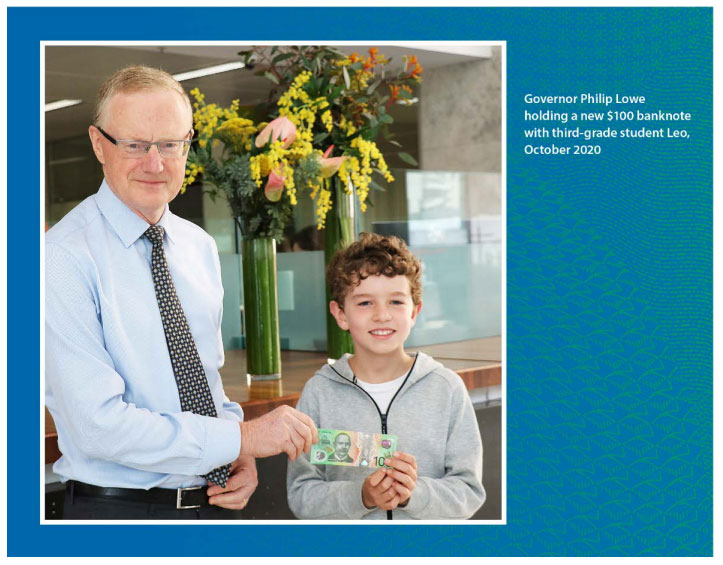
Note Printing Australia Limited (NPA)
NPA is a wholly owned subsidiary of the Reserve Bank that produces banknotes and passports for Australia. It also prints banknotes and other security products for other countries. In 2020/2021, NPA delivered 234 million Australian banknotes to the Bank, comprising 21 million new series $5 banknotes, 90 million new series $20 banknotes, 61 million new series $50 banknotes, and 62 million new series $100 banknotes. In comparison, in 2019/20, 331 million Australian banknotes were delivered to the Bank by NPA. For more details about NPA, see the chapters on ‘Governance and Accountability’ and ‘Operational Structure’.
The total amount paid by the Reserve Bank to NPA in 2020/21 for the supply of banknotes and related services was $74 million, compared with $90 million in the previous year.
In addition, NPA produced 1.13 million P Series passports for Australia's Department of Foreign Affairs and Trade in 2020/21. NPA also delivered 227 million banknotes under contract to Malaysia, Papua New Guinea, Singapore and Vanuatu, dealing directly with the respective central banks in those countries.
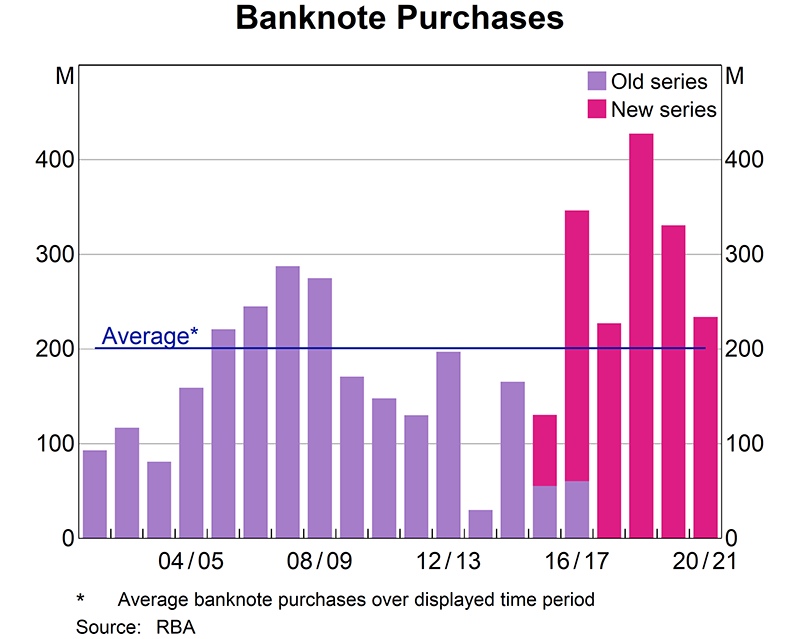
Endnotes
See Guttmann R, C Pavlik, B Ung and G Wang (2021), ‘Cash Demand During COVID-19’, RBA Bulletin, March. [1]
See Caddy J and Z Zhang (2021), ‘How Far Do Australians Need to Travel to Access Cash?’, RBA Bulletin, June. [2]
For additional information on the NGB program, see Hickie K, K Miegel, M Tsikrikas (2021), ‘Review of the NGB Upgrade Program’, RBA Bulletin, June. [3]
For additional information on a counterfeiting incident resolved through the actions of law enforcement agencies and the RBA, see Miegel K and K Symeonakis (2020), ‘A Counterfeit Story: Operation Gridline’, RBA Bulletin, December. [4]